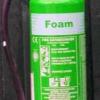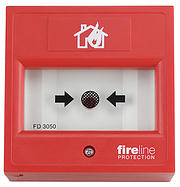-
Posts
674 -
Joined
-
Last visited
Posts posted by green-foam
-
-
The new units should come with a plug, I would guess that the original plug was lost and so some one soldered the wires on instead.
I am puzzled why you mention The "battery terminal" since mains powered smoke alarms are connected as follows.
Live, Neutral and "interconnect" This is repeated at every detector.
Since you will be replacing all 3 I would suggest you check (with a multi meter) at the first one which colour does what, since there are no strict guidelines for the colours, and then copy this colour code with all the detectors.
-
Like this one?

The requirement is for an area on the body of the fire extinguisher to be the "identifying colour" so the answer to your question is no.
-
I would NOT rely on an electrician, since they understand the concept of a fire alarm but they have no requirement to know the regulations of a fire alarm or its parts. (There is a difference between electricians and fire alarm engineers.)
It seems there is no specific regulation for cable fixing distance, (I think its BS7671) that says cables should be fixed at regular intervals, the question is, what is regular.
The "norm" does seem to be fix the cable at every 30cm.
-
I would suggest you offer to train some one (For a tiny fee) but as for doing it once a month then you invoicing them I don't think you will be doing it for long as you will have to make a "reasonable charge" which to them will be "xyz is only ripping us off"
-
Smoke detectors should be serviced / changed according to the manufacturers instructions.
Taking Appolo (a very popular brand) as an example, they should indeed be changed every 10 years, this is because that there is a slight possibility they may cause problems.
That said, you only need the detectors changing, not the bases.
-
Safelincs supply a variety of signs, some of which are self adhesive. CLICK ME
-
If its a Fire Alarm then the cable used must be flame resistant (such as FP200)

However if you have interlinked smoke alarms these are designed to be wired in "normal" 3 core and earth.

Below is a picture of several common Fire Alarm components.

Below is a picture of a smoke alarm

As you can see, the two are very different.
Smoke alarms are NOT fire alarms and they are NOT a substitute for a fire alarm and should NEVER be referred to as a fire alarm.
I would suggest you read the safelincs page which is HERE
-
For what its worth I would like to point out that at least once a year the EL's should be tested (No mains) for 3 hours, so you can make sure that all the lights will last this long. You can not really expect anyone to work with just EL's on / failing.
Also just because the indication LED is lit does NOT mean the EL will work as required. All the LED indicates is that the batteries are being charged.
-
Hi, Not wishing to appear to be pedantic but I should correct your question. Carbon monoxide is written as CO and is given off by unburnt materials which contain carbon, it is the same density as air and is colourless. (it is also flammable)
CO2 (that you said) on the other hand is heavier than air and is commonly found in fire extinguishers such as this one.

It is very important you do not confuse the two.
Back to your question.
Ideally a carbon monoxide detector should be installed adjacent / reasonable proximity to any appliance that is liable to produce carbon monoxide. To that end, most are designed to be wall mounted such as
 this one (available from HERE )
this one (available from HERE )Being wall mounted it is often not easy to conceal the cable, so most (not all) carbon monoxide detectors are battery operated.
If you want a mains operated CO detector you can get them from HERE
-
To add to what Harry said.
If it "beeps" every 90 seconds or so, it is indicating its batteries need replacing, it is NOT in alarm condition.
You should change the batteries, or if it is a sealed unit replace it.
If it is in "alarm condition" take it outside, wait for it to stop. Take it back inside, if it goes into alarm again, repeat, if it goes into alarm again it has detected carbon monoxide.
Safelincs can supply one which is a combined smoke and Carbon monoxide alarm, not only does it beep, it SPEAKS (So you know if its smoke or carbon monoxide) CLICK HERE For more information.
-
Maria, while you are waiting you can put up your own smoke alarms, safelincs can supply optical detectors with test and silence button for less than £14.00 CLICK HERE
-
I have to ask, why would you want to disconnect a life safety system?
-
Hi Chris, The extinguisher to which I refer, you did not throw, it has a lever and handle, and it really was the size of a grapefruit, but also as I mentioned, it is no longer available, and regretfully I do not recall its name.
The other thing to consider, in particular with the video clip you linked to, if you notice the "whole room" is on fire, the idea of most extinguishers is to quench the fire before it gets too big.
Regarding making carbon dioxide (I don't know how good your chemistry is, so bear with me) its actually very easy.
You mix sulphuric acid with sodium carbonate solution. (Other variants are also possible)
This will produce carbon dioxide, at some pressure, but the volume produced depends on how much of each chemical you have to start with. By doing this you will end up with carbon dioxide and "water" (For the sake of argument) what can you do with the water now you have your carbon dioxide?
The answer has been around for many years,

No, it hasn't been photo shopped, this is a genuine 1961 soda / acid fire extinguisher.
As for carbon dioxide as an extinguishant its good, but not really suitable for the home, take a chip pan fire for example, if Joe Bloggs home owner were to point a carbon dioxide extinguisher at burning oil and operate the extinguisher, all that would happen is instead of one small fire there would now be multiple fires due to the burning oil being blown everywhere, like wise, burning paper can be put out by carbon dioxide, but only if the burning paper is in a container, if its not, the carbon dioxide can blow it everywhere causing more fires.
As Harry said, you would be better off with a foam or water mist.
http://www.youtube.com/watch?v=G67B1gMs8EQ
Water mist is good because it can be used on almost anything, and is 100% water.
Your main obstacle (and I still wish you luck) is finding something that will extinguish more than one category of fire and is compact.
-
Watching the video, the detector DOES have a battery inside.
I guess this is almost / nearly flat and that is why the unit is beeping.
Although the battery is not meant to be changed, I wonder is there a link that can be removed to disable the battery?
It LOOKS LIKE the "outer cover" can be unclipped and swung open
(I did note it says "do not open unit" but in this case you don't seem to have much choice)
-
Hello Chris, my 2p worth on the subject.
As Harry almost said, you can forget CO2 because for domestic use it is very limited, and as it is under such pressure it has to be in a heavy canister in order not to burst.
A popular miss-conception is the actual discharge time of an extinguisher.
http://www.youtube.com/watch?v=V_Nmf1cVPcY
From the above you can see that even a big 2kg CO2 extinguisher does not last that long, so even if you could make a smaller one, and if it could be used in a domestic situation it would probably last 2-3 seconds.
In your quest, for which I wish you luck, you should consider the following;
It needs to be not too heavy.
Easy to use
Suitable for more than one class of fire.
As an aside, "Recently" there was a spherical extinguisher about the size of a grapefruit, its no longer available, but you have to ask yourself why?
You may also like to know there are "aerosol" fire extinguishers available, in my opinion they are only of use if an ashtray is on fire.
-
Normally emergency lights are fed from the existing lighting circuit*, (Often the nearest light) so no need for (as you put it) "lots of wires up and down the 3 storey building"
* This does depend on how your current lighting is actually wired.
If its not possible, you would only need to have one cable running from the consumers unit to the first emergency light, then daisy chained from there. Which is still not "lots of wires up and down the 3 storey building"
-
I cant help but wonder.
Deborah Hunt, are you asking do all the Manual Call Points have to be identical? (You say a mix of old and new)
I would say it depends what you call old and new.
Manual Call Points should have a "plastic element" that when pressed activates the alarm. If you still have call points with glass Then, yes these should be changed, BUT if you have differant brands of manual call point, each with a "Plastic element" then so long as they look similar I can not see them being a problem.

(Apart from picture size) The above are similar, but NOT identical

(Apart from size) If it looks like the one above that has glass, then yes, ideally these should be changed.
-
Hi, you may want to look at EN54-11 It also says that a Manual Call Point must be red.
-
I would have to ask, if you could have a solar powered emergency light how would it work?
In general, an emergency light will come on when there is a power failure to the lighting circuit. How would a solar emergency light "know" that there is a power failure to the normal lights? you would have to run a cable which would carry a mains voltage......which could charge a normal emergency light.
Also you would need to run a cable from each emergency light to a solar panel which is located in view of the sun. (Outside?) This cable could be used to........connect it to the mains.
What if it were an overcast day? solar panels need bright sunshine to work, how would it work at night as there is nothing to charge the batteries?
Safelincs can supply a mains operated emergency light for £15.59 Click here
Although there is no landlords supply, these lights use very little in electricity to charge they could be connected to a tenants supply instead.
-
1.When the alarm is beepingThe Alarm automatically monitors the cells every 40 secondsto ensure they are satisfactory. If a problem is identified it willgive a short beep every 40 seconds. If the unit is giving beepsthen check the following:(i) Check that the green mains power light is on. If it is off theAlarm has been powered from the cells and the beepsindicate they are depleted. Re-connect the mains, check fuse,circuit breakers and wiring. If in doubt contact a qualifiedelectrician. The beeps should cease within 2 hours as thecells charge up.(ii) Check that the hush button has not been pressedinadvertently (Ei151TL only). This also causes beeps every 40seconds for up to 15 minutes. Press the test button to cancelhush mode beeps.(iii) The cells may be depleted. The beeps should cease within2 hours as they charge up. Fully charged, the cells will provideup to 6 months back-up without mains power.(iv) On the Optical Smoke Alarms only(Ei156TLH) if the unit beeps and the red light does not flash at the same timeit indicates a problem with the smoke chamber - see Cleaningthe Smoke Alarm.If all of the above possible causes of beeps have been ruledout but the beeping has still persisted for over 2 hours with thegreen light on - the rechargeable cells are probably defective.
-
Following on from what Harry said, what happens if you switch the lights off (at the switch) in a room where the smoke alarm is. Does the "mains on" light go out after say 2 minutes.
-
The batteries in self contained emergency lights should be changed on an "as and when" basis OR at the end of their expected life, which ever comes first.
To expand on that.
Annually all emergency lights should be left to run on their batteries for a minimum of 3 hours. Any that do not last 3 hours should be changed immediately.
Depending on make of battery, they each have a differing life expectancy. When the life expectancy date expires the batteries should be changed. Some makes it is 4 years some it is 5 years.
I suggest that when a battery is changed the date of installation is written on the battery for future reference.
Safelincs supply spare batteries CLICK HERE
-
If its a two wire system each unit with its own integral sounder and wired in twin and earth, the probability is that it has been installed by an electrician, which then brings into question is the alarm actually suitable for its location, and what else is wrong.
I would also have to ask, if you serviced it, what is your normal job? sorry, but I can not help but wonder why you are asking such a question if you are servicing a fire alarm.
-
What does the wash care label on the curtains say?
If you can't find it, go back to where you brought the curtains and ask them.




How often do fire alarms need to be tested?
in Fire Alarm Systems
Posted
It always been once a week.
But saying that you don't test everything once a week, you pick a random call point and activate it, then next time you should pick a different call point. (In reality its often the same one) But you must make sure all sounders activate.
I think you are confusing servicing a fire alarm with testing a fire alarm. Servicing is every quarter, testing should be every week. (At the same time so people know it is only a test)